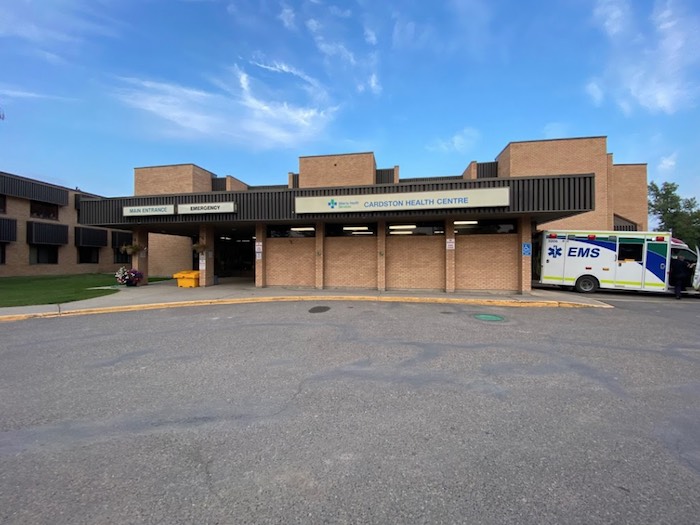Alberta
Province trumpets $105 million in new health spending for Rural Health Facilities Revitalization Program

Strengthening rural health care
Budget 2023 expands rural health supports so Albertans can have additional access to modern health facilities and the care they need where and when they need it.
Alberta’s government is committed to expanding and modernizing rural hospitals and other health facilities across the province to protect quality health care, grow system capacity and support the best front-line health care workers in the world.
Having access to quality health care when and where Albertans need it includes expanding capacity to provide better access for Albertans living in rural and remote areas of the province.
“We are making sure we have the necessary funding in place to build and strengthen health care in our rural communities and address barriers to care for those looking for support and treatment close to home and family. This work includes programs that focus on how to recruit, retain and even train more physicians, nurses and other professionals in areas outside of the cities.”
Budget 2023 provides $105 million over three years for the Rural Health Facilities Revitalization Program, including $75 million in additional funding for capital projects in rural Alberta.
The program supports strategic renovations and developments in health facilities throughout the province, with an emphasis on emergency departments, EMS stations, surgical and dialysis clinics, and other clinical services to improve access to health care in rural Alberta.
Expanding capacity in the health care system also means having health care workers to fill those spots. In response, Alberta’s government launched the Health Workforce Strategy to attract and retain the health care workers needed now and create more training opportunities for local students and internationally trained medical graduates.
“All Albertans, no matter where they live, need and deserve access to our health system. Physicians are a critical part of that system, especially in rural areas where we are trusted to support the needs of neighbours, friends and colleagues during all phases of life. It is a special calling to work in rural health care, but it can be tremendously rewarding for those who pursue it.”
Rural Albertans are especially affected by the nationwide shortage of health care workers. To address this growing need, the Health Workforce Strategy provides $113 million to add 100 residency training spaces for newly graduated doctors, particularly in rural areas and specialist fields. Creating these new training spaces will provide more opportunities for Alberta students to learn, train and practise in their home communities.
In addition to this investment, a further $1 million will go toward exploring ways that regional post-secondary institutions, such as the University of Lethbridge and Northwestern Polytechnic in Grande Prairie, can help deliver medical education outside of Edmonton and Calgary.
“Whether it’s emergency care or surgeries, primary care or continuing care, Albertans deserve equitable health care services in their communities. I am proud of the investments government is making through Budget 2023, both with infrastructure funding and workforce planning strategies, to help support the future of rural health care in our province.”
This year’s budget also funds the new agreement with the Alberta Medical Association, further stabilizing the health system and focusing on Alberta’s rural communities. Under the agreement, more than $250 million over four years will go to addressing pressures, including recruitment and retention programs so more Albertans can access family doctors, and supporting physicians so their practices remain viable.
Budget 2023 secures Alberta’s future by transforming the health care system to meet people’s needs, supporting Albertans with the high cost of living, keeping our communities safe and driving the economy with more jobs, quality education and continued diversification.
Quick facts
- The Rural Health Revitalization Program provides capital funding for revitalizing select rural health facilities throughout the province.
- Budget 2023 invests $105 million over three years for the Rural Health Facilities Revitalization Program. This includes $75 million in additional funding for new capital projects in rural Alberta.
- To date, about $65 million has been committed to 22 projects across the province, including emergency department renovations, upgrades to EMS stations and new dialysis spaces.
- An investment of $237 million over three years towards the Alberta Surgical Initiative Capital Program will help reduce surgical wait times and help Albertans receive the surgeries they need.
- This includes $120 million in new funding for projects in 15 communities across the province to expand and modernize operating rooms in public hospitals.
- Budget 2023 includes $64 million over three years to continue the La Crete Community Health Centre capital project to provide increased access to maternity health services.
- $11 million over three years is part of a $23.5-million commitment to expand the renal dialysis program at the Chinook Regional Hospital in Lethbridge.
- This project will relocate the dialysis unit to provide additional treatment spaces and address patient and staff safety concerns with the current site.
- $3 million over three years in planning dollars is committed to the North Calgary/Airdrie Regional Health Centre.
- $3 million over three years in planning dollars is committed to expanding the Strathcona Community Hospital.
- Planning dollars are also committed for new or upgraded facilities in Bassano, Cardston and Whitecourt.
Alberta
Alberta Independence Seekers Take First Step: Citizen Initiative Application Approved, Notice of Initiative Petition Issued

Alberta’s Chief Electoral Officer, Gordon McClure, has issued a Notice of Initiative Petition.
This confirms a Citizen Initiative application has been received and the Chief Electoral Officer has determined the requirements of section 2(3) of the Citizen Initiative Act have been met.
Approved Initiative Petition Information
The approved citizen initiative application is for a policy proposal with the following proposed question:
Do you agree that Alberta should remain in Canada?
The Notice of Initiative Petition, application, and statement provided by the proponent are available on Elections Alberta’s website on the Current Initiatives Petition page.
As the application was received and approved prior to coming into force of Bill 54: Election Statutes Amendment Act, the Citizen Initiative process will follow requirements set out in the Citizen Initiative Act as of June 30, 2025.
Next Steps
- The proponent must appoint a chief financial officer within 30 days (by July 30, 2025).
- Once the 30-day publication period is complete and a chief financial officer has been appointed, Elections Alberta will:
- issue the citizen initiative petition,
- publish a notice on the Current Initiatives Petition page of our website indicating the petition has been issued, specifying the signing period dates, and the number of signatures required for a successful petition, and
- issue the citizen initiative petition signature sheets and witness affidavits. Signatures collected on other forms will not be accepted.
More information on the process, the status of the citizen initiative petition, financing rules, third party advertising rules, and frequently asked questions may be found on the Elections Alberta website.
Elections Alberta is an independent, non-partisan office of the Legislative Assembly of Alberta responsible for administering provincial elections, by-elections, and referendums.
Alberta
Alberta’s government is investing $5 million to help launch the world’s first direct air capture centre at Innisfail

Taking carbon capture to new heights
Alberta’s government is investing $5 million from the TIER fund to help launch the world’s first direct air capture centre.
Alberta is a global leader in environmentally responsible energy production and reducing emissions, already home to two of the largest carbon capture, utilization and storage facilities operating in North America, and seeing emissions decline across the economy.
Most of the current technologies used around the world focus on facilities and worksites. Direct air capture offers a potential new way of removing greenhouse gas emissions straight from the air. If successful, the potential is huge.
Through Emissions Reduction Alberta, $5 million is being invested from the industry-led TIER program to help Deep Sky in the design, build and operation of the world’s first direct air capture innovation and commercialization centre in Innisfail. This funding will help Alberta keep showing the world how to reduce emissions while creating jobs and increasing responsible energy production.
“We don’t need punitive taxes, anti-energy regulations or nonsensical production caps to reduce emissions. Our approach is to support industry, Alberta expertise and innovation by helping to de-risk new technology. Direct air capture has some potential and is being looked at in other jurisdictions, so it’s great to see companies choosing Alberta as a place to invest and do business in.”
“Alberta companies are leaders in developing carbon capture and storage technology. Deep Sky has the potential to take the next major step in decarbonization through direct air capture. These advancements and investments through the TIER fund are a major reason why global demand is increasing for our responsibly produced energy products.”
“Investing in Deep Sky supports Alberta’s global leadership in emissions reduction. This project accelerates cutting-edge carbon removal technologies, creates jobs and builds a platform for innovation. By capturing legacy emissions, it complements other climate solutions and positions Alberta at the forefront of a growing carbon removal economy.”
“We are thrilled to be supported by the Government of Alberta through Emissions Reduction Alberta’s investment to help deliver a world first in carbon removals right here in Alberta. This funding will be instrumental in scaling direct air capture and creating an entirely new economic opportunity for Alberta, Canada and the world.”
Deep Sky is helping establish Alberta as a global leader in carbon removal – an emerging field that is expected to grow exponentially over the next decade. The new centre is located on a five-acre site and will feature up to 10 direct air capture units, allowing multiple technologies and concepts to be tested at once. Starting this summer, Deep Sky Alpha’s units will begin pulling in air, trapping carbon dioxide, transporting it by truck, and safely storing it underground at an approved site in Legal.
This new technology will give Alberta’s oil and gas, energy and utilities, cement and heavy industry, and agriculture and agri-tech sectors new technologies to reduce emissions, while creating local jobs and reinforcing Alberta’s position as a global leader in responsible energy development.
Quick facts
- Deep Sky aims to capture 3,000 tonnes of emissions each year and estimates creating 80 construction jobs, 15 permanent jobs, and more than $100 million in local economic benefit over the next 10 years, including regional development in rural communities.
- Research shows that carbon capture technology is safe and effective. Careful site selection and rigorous monitoring serve to ensure the injected carbon dioxide remains sequestered thousands of metres below the surface, with no impact on fresh water, plants or the soil.
- Provincial funding for this project is delivered through Emissions Reduction Alberta’s Continuous Intake Program, funded by Alberta’s industry-funded Technology Innovation and Emissions Reduction (TIER) system.
Related information
-

 Brownstone Institute2 days ago
Brownstone Institute2 days agoFDA Exposed: Hundreds of Drugs Approved without Proof They Work
-

 Energy1 day ago
Energy1 day agoChina undermining American energy independence, report says
-

 Business1 day ago
Business1 day agoTrump on Canada tariff deadline: ‘We can do whatever we want’
-

 Automotive1 day ago
Automotive1 day agoElectric vehicle sales are falling hard in BC, and it is time to recognize reality.
-

 Business1 day ago
Business1 day agoEurope backs off greenwashing rules — Canada should take note
-

 Automotive1 day ago
Automotive1 day agoPower Struggle: Electric vehicles and reality
-

 Business3 hours ago
Business3 hours agoCanada Caves: Carney ditches digital services tax after criticism from Trump
-

 Crime3 hours ago
Crime3 hours agoSuspected ambush leaves two firefighters dead in Idaho






